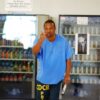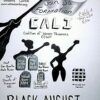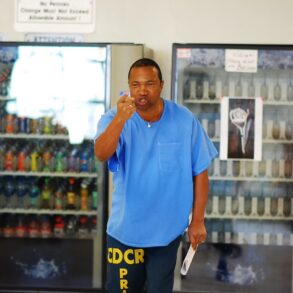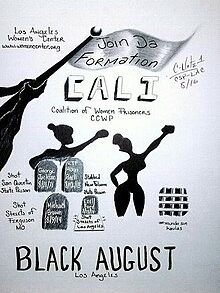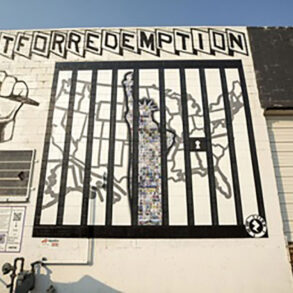
“My work doesn’t aim to say anything, because that means work, that means slavery, because it’s for a purpose. I just want to create for the purity of creating. On the other hand, I am always being intentional in the work I create. Let’s say I am going to be in an exhibition, then I usually create a work that reflects the theme or the name of the exhibition, and quite often title the artwork after the exhibition. But I most definitely do social commentary work that has gotten recognition all on their own. I’ve been primarily drawing since 2000, and created my first work in 2009, “My Dilemma.” In 2016, I created my first political work, “Black August – Los Angeles.” I donated Black August – Los Angeles to the Roman Catholic Archdiocese of Los Angeles. Black August – Los Angeles is listed in Wikimedia Commons’s extensive Library, as one of only 12 artworks in its Black Cultural Archives, and is featured in the Wikipedia article, “Black August (Commemoration).” The 2017, Hurricane Harvey inspired “During the Flood,” to which I intentionally created as a Public Service Announcement (PSA), regarding awareness to future prisoner fatality exposure due to natural disaster flooding, was used by grassroot organizations and individuals during Category 5 and 4 Hurricanes Dorian and Ida for prison evacuations. It was also featured in Mutual Aid Disaster Relief’s zine, “Prisoners In Disaster: Legacy of abuse, exploitation, and endangerment of prisoners and disaster.”
In July of 2017, I created the drawing “Incarceration Nation,” a PSA for the August 19, 2017, Millions for Prisoners Human Rights March. It was for a march in Washington DC, across the United States and the globe. Incarceration Nation has since become America’s premier artwork on mass incarceration. Incarceration Nation was featured in the fashion line “Mercy.” A fashion line created in 2020 by Mackenzie Stiles, a senior fashion design student at the Columbus College of Art and Design, for her undergraduate thesis. It was the first time in the 144-year history of the CCAD, a student incorporated prison art into a clothing line design. Covid-19 health restrictions in the spring of 2020, prevented the 2020 CCAD Fashion Show, which would have marked a historic moment in the history of the Catwalk, by becoming the first time fashion models would have walked the runway in outfits crafted using prison art.
In 2021, the outdoor art exhibition (Oct. 17 – Nov. 16, 2021), “Look Up!”, featured Incarceration Nation as a billboard art installation. Curated by Anna D. Smith of the Silicon Valley based Anna D Smith Fine Art and Real Estate Broker, It was the first time a prisoner in the United States had one of their artworks to be featured on a billboard. The exhibition led to the Better San Jose Peaceful Rally. A rally held on Tuesday, November 2, 2021, from 1 p.m. to 3 p.m. at 861 West San Carlos, San Jose, California, at the Incarceration Nation Billboard Art Installation. The rally addressed issues, such as San Jose’s homeless youth and returning citizens, the power of Education through High School Graduation, Trades, and University Degrees, and the lack of a credible response from local elected officials, from San Jose Mayor, the San Jose City Council members and the Santa Clara County Board of Supervisors. Incarceration Nation has been featured as the lede image in several digital articles and is featured in the Wikipedia article, “Prison Art.” In 2018, I created the Paintoem (painting + poem), “Today We Are Sisters.” The paintoem was created to stir a reparations movement for providing California women prisoners with reparations who were forcibly sterilized.
In 2017, I heard a news story on the local public radio station regarding California’s forced sterilization history and that an active search was being done to find these victims and to give them reparations. From 1909, until the law was repealed in 1979, the State of California had a forced sterilization law. It inspired Nazi Germany to create one of its own. The target of California’s forced sterilization law were people with Spanish surnames. After the law was repealed, California was secretly forcibly sterilizing its women prisoners. What spurred me into all this as an artist, were these women prisoners were not a part of the people the government were searching for to provide reparations. Today We Are Sisters is about an agreement between Pro-Life advocates, and Pro-Choice advocates to come together to fight for the end of California to forcibly sterilize its women prisoners, and to provide them with reparations. In 2018, I donated the drawing to the California Coalition for Women Prisoners (CCWP). That same year, and every year thereafter, the CCWP went to the state capitol to demand an end to the practice of forced sterilization and to provide reparations. In 2020, film producer Erika Cohn released “Belly of the Beast.” It exposed a history of forced sterilizations of female prisoners in California’s prisons. The winter of 2020, saw the release of Free Virtual Art Exhibition (1-Artist; 1-Subject; 21-Works), which featured 21 of my artworks related to the incarceration experience. It concluded with Today We Are Sisters. Shortly thereafter, California legislators would pass a 7.5M reparations bill for these women prisoners. California Governor Gavin Newsome signed the bill into law, and this December 31st is the cutoff date to file an application, so now I am working with others, including fellow artists to raise awareness regarding this deadline.”
This post was originally published on this site be sure to check out more of their content

